The Twelve Days of Christmas – aquatic invasive species awareness style!
‘Tis the season to spread some holiday cheer and, of course, some aquatic invasive species awareness!
Michigan Sea Grant Extension is a member of the regional Great Lakes Sea Grant Network. We collaborate with other state programs around the region in a number of ways and on a number of topics, including aquatic invasive species (AIS). AIS education is something in which both Sea Grant and Michigan State University Extension are engaged, and as we approach Christmas, it is the perfect season to spread some holiday cheer as well as AIS awareness. We hope you enjoy the following AIS version of the “The Twelve Days of Christmas” adapted, with permission, from Tim Campbell’s original Wisconsin Sea Grant version.
On the twelfth day of Christmas, a canal brought to me: Canals have been a significant source of invasive species into the Great Lakes region. Canals can be an invasion pathway by opening previously unavailable habitat to a species (e.g. alewives, lamprey) or by allowing ships with AIS in their ballast to enter the Great Lakes (e.g. quagga mussels, spiny water flea). In fact, the pathway into the Great Lakes region for nearly all of the invasive species in this jingle can be easily tied to a canal.
Twelve quaggas clogging — Quagga mussels are now the dominant invasive mussel in Lake Michigan. A member of the same genus as zebra mussels, the quagga 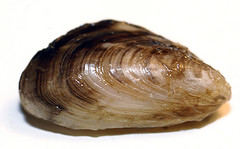 mussel can tolerate colder water and colonize soft substrates. Just like zebra mussels, quagga mussels are quite effective at clogging water intake pipes and other infrastructure. Mitigating these impacts has cost Great Lakes residents millions of dollars.
mussel can tolerate colder water and colonize soft substrates. Just like zebra mussels, quagga mussels are quite effective at clogging water intake pipes and other infrastructure. Mitigating these impacts has cost Great Lakes residents millions of dollars.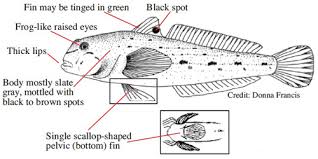
‘Leven gobies gobbling — The round goby is very fond of fish eggs. It is a known predator of lake sturgeon and lake trout eggs, and a swarm of round gobies can decimate a smallmouth bass nest. They can also consume zebra and quagga mussels which can cause toxins to move up the food chain (bioaccumulate). The best ways to prevent future inland round goby invasions is to not use round goby as bait and to not move live fish.
Ten alewives dying — Alewives are one of the few invasive species that foul Great Lake’s beaches throughout the summer. Until the introduction of Pacific salmon, alewives died off in such great numbers that tractors were required to remove them from beaches. Salmon now do a great job controlling alewife numbers, but there are still alewife die-offs due to spawning and temperature related stresses.
Nine eggs in resting —The spiny waterflea and the fishhook waterflea produce tiny resting eggs that can survive extreme environmental conditions, so it is imperative to make sure that recreational equipment is cleaned to prevent spreading these invasive crustaceans. 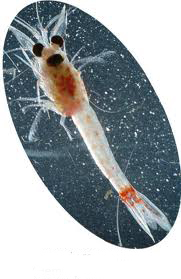
Eight shrimp ‘a swarming — The bloody red shrimp is one of the Great Lakes more recently discovered ballast invaders. Bloody red shrimp swarms can be incredibly abundant, with swarms up to 1500 individuals/square meter being documented. Their effects on the Great Lakes are largely unknown, but they may compete for food with young fish, and have been found in the diet of some fish in the Great Lakes. Regardless of the impacts, eight shrimp ‘a swarming is a huge underestimate.
Seven carp and counting — There are seven species of non-native carp in the United States. There are the four collectively known as Asian carp (black, grass, silver, and bighead), the common carp, the crucian carp, and last but not least, the Prussian carp (a wild version of the goldfish). While the current focus is on the silver and bighead carp, all of these carp cause problems one way or another. Hopefully we won’t actually be counting any other carp species soon.
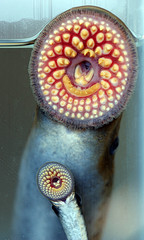 Six lamprey leaping — This is some bad lamprey biology humor. Lampreys are actually poor jumpers, especially when compared to trout and salmon, so a small low-head obstacle or ledge can prevent lampreys from moving further upstream while other fish leap over the obstacle. Thus, physical barriers are one way managers are preventing lampreys from invading more streams in the Great Lakes basin.
Six lamprey leaping — This is some bad lamprey biology humor. Lampreys are actually poor jumpers, especially when compared to trout and salmon, so a small low-head obstacle or ledge can prevent lampreys from moving further upstream while other fish leap over the obstacle. Thus, physical barriers are one way managers are preventing lampreys from invading more streams in the Great Lakes basin.
FIVE BOAT WASH STATIONS! — Boat washing can include any steps that clean a boat, but watercraft decontamination steps include AIS removal actions that go beyond draining water and removing vegetation. Often times these steps involve the use of pressure washing equipment. Decontamination stations might not always be necessary, especially if you can take part in the third day’s gifts.
Four white perch on ice — Icing your catch is another way anglers can help prevent the spread of invasive species. Many invasive species aren’t readily visible to the naked eye, including zebra and quagga mussel veligers, or spiny and fishhook waterfleas. Icing the day’s catch makes it so anglers don’t need to transport water and the organisms in it, while also improving table fare. The invasive white perch would go well on ice, as would the yellow perch and any of the other delicious fish species found in Michigan. A fish on ice is twice as nice; that’s a win-win if I’ve ever heard one.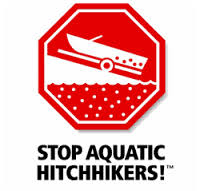
Three clean boat steps — Clean. Drain. Dry. Follow those three simple steps to Stop Aquatic Hitchhikers (the name of one of our regional Sea Grant collaborations). Not already familiar with the three clean boat steps? Here they are in a little more detail: Clean any weeds, mud, and debris from your boat, motor, and trailer. Drain any water from the boat, motor, live wells, bait wells, and bilge. Dry any equipment that came in contact for more than five days, especially if you will be using it on a different water body.
“Two” much phragmites — The giant common reed can grow in excess of 4 meters and out competes native rooted aquatic plants such as cattails. Phragmites can spread both by seed dispersal and by rhizome fragments that break off and are transported elsewhere. Dense phragmites stands can even alter the hydrologic regime of invaded wetlands by increasing evaporation and trapping sediment. Economic impacts include reductions in property values and revenue loss from impacted recreational activities, due to impeded access to coastal areas and restricted views.
And a carp barrier in the city! — There are actually three electric barrier arrays in the Chicago Sanitary and Ship Canal. Two of the barriers are always on, while the other is on standby to provide emergency backup or to be functional during periods of maintenance. This configuration has prevented fish from moving upstream of the barriers. As long as the electricity remains on, these barriers should prove to be effective at preventing additional silver and bighead carp from entering the Great Lakes until a more permanent solution can be found.



 Print
Print Email
Email




